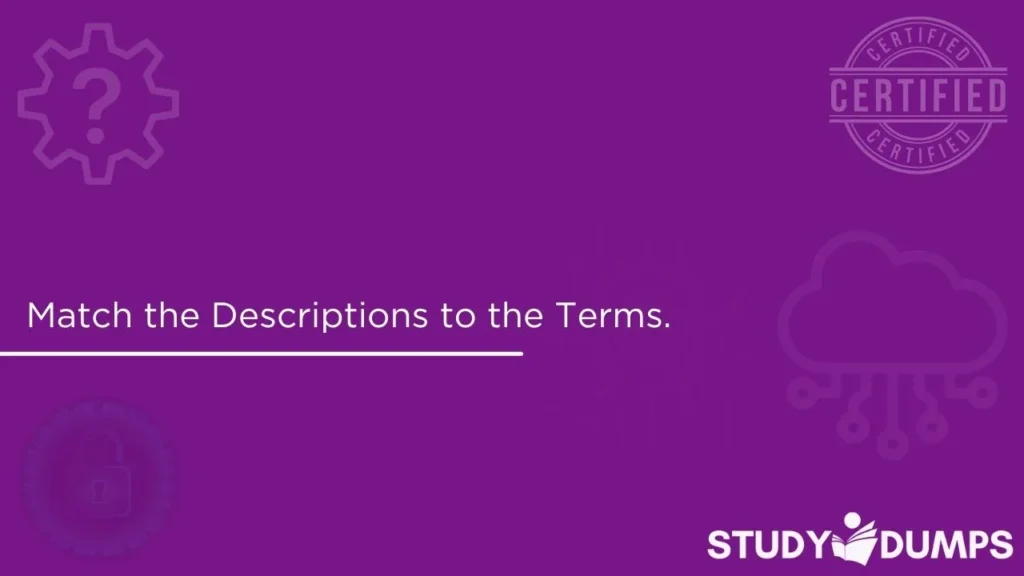Your Ultimate Guide to Match the Descriptions to the Terms. (Not All Options Are Used.)

When preparing for IT certification exams, you’ll often come across the instruction “match the descriptions to the terms. (not all options are used.)”. This question format is used to assess your understanding of multiple concepts and your ability to associate definitions with the correct terms. It’s common in exams such as Cisco CCNA, CompTIA A+, Microsoft AZ-900, and others found on the StudyDumps platform.
In this question type, you’re provided with several descriptions and a list of terms. Your task is to correctly match the descriptions to the appropriate terms. However, some terms listed will not be used. This is where most candidates get confused.
Table of Contents
Why This Question Type Matters
Questions that say “match the descriptions to the terms. (not all options are used.)” test both memory and comprehension. They aren’t just about recalling definitions; they test your ability to distinguish between closely related concepts. You must not only know the correct term but also eliminate incorrect ones.
This format can appear in topics like network devices, programming structures, system components, and cloud services. Failing to understand how these questions work can cost you valuable exam marks, even if you know the content well.
How to Approach These Questions
Read All Descriptions Carefully
Start by reading every description carefully. Pay attention to key verbs and technical terms. For instance, if the description mentions “routes traffic between networks,” you’re likely looking at a router, not a switch.
Scan the Terms List
Before matching, scan through all the options. Mentally eliminate any that are obviously unrelated. This makes your job easier when you start matching.
Use the Process of Elimination
This is key because not all terms are used. If a term doesn’t fit any description, cross it out mentally or on your scratch paper. You can also narrow down by first finding the most obvious matches.
Match the Obvious Ones First
Find the easiest descriptions to match and solve them first. This gives you confidence and reduces the number of remaining terms to consider for harder matches.
Review Your Answers
After making your matches, go through each one again. Make sure the description actually defines the term you’ve selected. Double-check that the unused terms truly don’t fit any description.
Example Topics Where This Question Type Appears
- Network Components
- Cloud Service Models
- Cybersecurity Tools
- System Software
- Operating System Functions
- Programming Constructs
Common Mistakes to Avoid
Assuming All Terms Are Used
Many students automatically assume that all listed terms must be matched. This often leads to forcing incorrect answers. Remember, the keyword says “not all options are used.”
Matching Based on Partial Clues
Sometimes a description seems to fit two terms slightly. Only one will be fully correct. Always choose the term that fits the entire description, not just part of it.
Ignoring the Instruction
Never skip the instruction part of the question. If it says “not all options are used,” take that into account. It’s not a trick—it’s a test of your critical thinking.
Benefits of Practicing This Format
Practicing match the descriptions to the terms. (not all options are used.) questions improves your:
- Attention to detail
- Logical reasoning
- Conceptual clarity
- Ability to eliminate wrong options
- Performance in actual certification exams
Best Practices for Preparation
- Practice matching questions from all topics in your syllabus
- Time yourself to simulate real exam pressure
- Review why certain options are not used after solving each question
- Use study guides and practice dumps from trusted sources like StudyDumps.net
- Revise technical terms and definitions regularly
Final Thoughts
In competitive IT and certification exams, every question format plays a role in determining your score. The match the descriptions to the terms. (not all options are used.) type is not only about knowledge but also about applying that knowledge smartly. When you understand how to approach these questions, you gain a powerful advantage.
StudyDumps offers reliable, updated practice materials and mock exams tailored for success. Whether you’re preparing for CompTIA, Cisco, or Microsoft certifications, mastering this question format can help you reach your certification goals with confidence.
Keep practicing, stay focused, and you’ll master even the trickiest matching questions.
Sample MCQs: Match the Descriptions to the Terms. (Not All Options Are Used.)
Sample Question 1: Network Devices
Match the descriptions to the terms. (Not all options are used.)
Descriptions:
- Connects multiple networks and routes packets
- Operates on Layer 2 and forwards frames using MAC addresses
- Regenerates signals and extends the network
Terms:
A. Switch
B. Router
C. Firewall
D. Repeater
Correct Answers:
1 – B. Router
2 – A. Switch
3 – D. Repeater
(Option C. Firewall is not used)
Sample Question 2: Operating System Functions
Match the descriptions to the terms. (Not all options are used.)
Descriptions:
- Manages communication between hardware and software
- Accepts and processes user commands
- Allows the user to run productivity programs
Terms:
A. Kernel
B. Shell
C. Application
D. BIOS
Correct Answers:
1 – A. Kernel
2 – B. Shell
3 – C. Application
(Option D. BIOS is not used)
Sample Question 3: Cybersecurity Concepts
Match the descriptions to the terms. (Not all options are used.)
Descriptions:
- Type of malware that demands payment
- Prevents unauthorized access to a network
- Scans software for malicious behavior
Terms:
A. Firewall
B. Antivirus
C. Ransomware
D. Worm
Correct Answers:
1 – C. Ransomware
2 – A. Firewall
3 – B. Antivirus
(Option D. Worm is not used)
Sample Question 4: Cloud Models
Match the descriptions to the terms. (Not all options are used.)
Descriptions:
- Complete infrastructure including networking and storage
- Platform to deploy applications without managing hardware
- Application provided over the internet
Terms:
A. IaaS
B. SaaS
C. PaaS
D. Virtualization
Correct Answers:
1 – A. IaaS
2 – C. PaaS
3 – B. SaaS
(Option D. Virtualization is not used)

